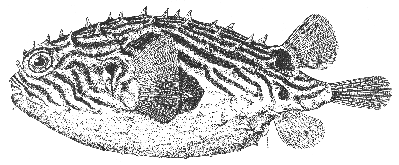Burrfish Chilomycterus schoepfii (Walbaum) 1792 [13]
PORCUPINEFISH; RABBITFISH; OYSTERFISH
[Jordan and Evermann, 1896-1900, p. 1748.]

Figure 281.—Burrfish (Chilomycterus schoepfii), Connecticut. From Goode. Drawing by H. L. Todd.
Description—
The burrfish resembles the puffer (p. 526) in the positions of its dorsal and anal fins, but its skin is armed with short, stout, triangular [page 528] spines instead of being merely prickly. These spines are sparsely scattered all over the trunk, with about 9 or 10 from nose to tail along any given line. Furthermore, the burrfish is oval in outline, not fusiform like the puffer; the openings of its nostrils are prolonged in a single tubular tentacle; its bony jaw plates are not divided by a median suture as they are in the puffer, hence each jaw apparently is armed with a single very broad incisor tooth instead of with two; the pectoral fins are not only much larger than in the puffer but their upper edge is level with the upper corner of the gill openings in the burrfish (considerable below it in the puffers); its eye is round, not oval; and its anal fin is below the dorsal, not behind the latter. We need only add that the soft dorsal and anal fins (it has no spiny dorsal) are both rounded, each has 10 to 12 rays; the caudal fin is very narrow and round-tipped; the pectorals are much broader than long, and there are no ventral fins.
Color—
The ground color varies from green to olive or brownish above, with pale belly, usually tinted with yellow or orange. The back and sides are irregularly striped with olive brown, dusky, or black lines, running downward and backward, roughly parallel one with another. There is a dark blotch on each side at the base of the dorsal fin, a smaller one between the latter and the anal fin, one above the base of each pectoral fin, and a fourth close behind the latter.
Size—
Length, to about 10 inches.
General range—
Coast of the United States, from Florida northward regularly about to New York, occasionally to Cape Cod, and straying as far as Massachusetts Bay; most plentiful from the Carolinas southward.
Occurrence in the Gulf of Maine—
The only record of this southern fish north of the elbow of Cape Cod is of one taken in Massachusetts Bay many years ago[14] and another caught at West Point, Maine, August 5, 1949.[15]
[13] Jordan, Evermann, and Clark place this species in the genus Cyclichthys Kaup 1855.
[14] This specimen, reported by Kendall (Occas. Paper, Boston Soc. Nat. Hist., vol. 7, Pt. 8, 1908, p. 118) is (or was) in the collection of the Boston Society of Natural History.
[15] Taken in a fish trap and reported by Scattergood, Trefethen, and Coffin (Copeia, 1951, No. 4, p. 298).